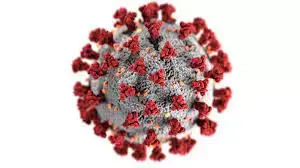In a nutshell, we showed that over-the-counter cheap generic antibiotic neomycin can be repurposed in nasal formulation to prevent & treat infection, block transmission, and reduce disease burden against a wide array of viruses. Since this is a host-directed strategy and virus-agnostic, it holds promise as a prophylactic strategy against any viral threat.
The advice in the screencapped thread was to apply a little with a q-tip to the inside of the nostrils.
There is no info on any dangers of doing this very often, but if you can’t avoid a high-risk environment it’s worth trying.
Here’s a thread about the study. https://threadreaderapp.com/thread/1782535781338222960.html
here’s the study: https://www.ncbi.nlm.nih.gov/pmc/articles/PMC5918160/
Also, just wear an N95 mask. But I see no reason not to do both.
I am not anything, but a doc during am outdoor first aid cert course insisted that the real benefit of Neosporin was that it was petroleum jelly and it created a hydrophobic/biologically inert barrier over cleaned/irrigated membranes and wounds (blocking vectors of infection), and that every bug was already resistant to its antibiotic mix and had been for decades.
I did take a bunch of biology and microbio and he made a very convincing case for using petroleum jelly on nicks, cuts, etc.
but I am, again, not any sort of human health professional.
There’s an old folk remedy that putting petroleum jelly around your nostrils helps hayfever, by absorbing pollen, I imagine that could be what’s happening here.
petroleum jelly around your nostrils helps hayfever, by absorbing pollen
you have nothing to lose but your grains

This isn’t saying the antibiotic prevents covid it’s saying it stimulates an anti viral response in the nose, thats separate from it being an antibiotic so resistance doesn’t matter
Yeah, this is what I was thinking
frankly, it’s amazing to me that the mouse HSV challenge study didn’t run a trial with petroleum jelly only
deleted by creator
After some further reading: doing that control would have been better science, but it seems the mouse sars-cov2 and influenza challenge studies’ results indicate that might not be necessary except to rule out the role of petroleum jelly itself:
Honestly the risk of doing this occasionally (How often are you taking flights anyway? What are you Taylor Swift or something?) would almost certainly be lower than the risk of contracting covid even once, let alone for a subsequent time.
I’m not a doctor and this is not medical advice but… if you asked a covid specialist doctor which is worse for you - a full course of antibiotics or contracting covid, I know how they would answer. And applying a small amount of neosporin inside your nostrils is not nearly on the same level as a course of antibiotics.
I feel like it’s just a physical barrier. Like if you used Vaseline instead you would get the same result.
Or a mask 🙄
Por que no los dos?
Those paper masks is only really effective on protecting others from you, not other way around.
Yes, everyone should be wearing tight n95s, good point.
Lol dumbass
is this not the antibiotic abuse that we’ve been warned about since forever? Not using antibiotics when there isn’t an open wound, or a microbial infection?
I mean, neosporin isn’t prescribed, but still.
It’s not being used to treat a bacterial infection in this case, whatever properties it has causes the immune system in the nose to go into virus-attacking mode. So I would think the of overuse is minimal.
Probably not best to use it daily, but for occasional high risk situations it shouldn’t be a problem.
Prophylactic use of antibiotics is still use of antibiotics, even if it’s being used for stimulation of toll like receptors. The bacteria don’t care if you’re trying to kill them or not. Benign organisms can still develop resistance to an agent and pass it off to hostile ones.
Now, resistance to this particular agent is not uncommon, so it’s not catastrophically harmful to use it for that purpose. Other antibiotics see use for purposes other than killing or suppressing the growth of bacteria as well (erythromycin for gastric motility, for example). I’m curious about the actual degree of benefit this measure confers in a human sample population, and am generally not a fan of putting petrolatum-based products where I can inhale them as I’m paranoid about accidentally giving myself lipoid pneumonia.
It doesn’t sound like you need to coat the inside of your nose, just put enough to trigger an immune reaction, so I would guess occasional use wouldn’t destroy your nasal biome. Plain neomycin without the petroleum jelly should work the same, if you want to avoid petroleum jelly.
This needs more study to measure exactly how effective it is, but the one of the researchers doing the study, Prof Akiko Iwasaki, is a highly regarded immunobiologist.
A concern I have about this is the long term effect on the nasal microbiome. In the same way that using antibiotics orally can fuck up your gut microbiome and lead to an increased risk of other health problems, could fucking up the nasal microbiome lead to poorer viral resistance in the long term, or an increased chance of developing allergy/histamine/MCAS issues (which are already triggered by COVID infections)?
The authors share your concerns
Our results demonstrate a surprising and broad antiviral effect of the aminoglycoside family of antibiotics, when applied to mucosal surfaces. However, we do not advocate for use of these compounds as antivirals, as aminoglycoside application is expected to cause local dysbiosis of commensal bacterial community.
Totally get the concern here, but I don’t think we have any idea of how the nasal microbiom impacts overall health. We’re really just now realizing how important the gut microbiome is, I doubt they’ve looked much at the nose.
Seems to me like actual anti-virals like iota-carrageenan (Betadine brand) nasal spray would be more effective…
The incidence of COVID-19 differs significantly between subjects receiving the nasal spray with I-C (2 of 196 [1.0%]) and those receiving placebo (10 of 198 [5.0%]). Relative risk reduction: 79.8% (95% CI 5.3 to 95.4; p=0.03). Absolute risk reduction: 4% (95% CI 0.6 to 7.4).
https://www.ncbi.nlm.nih.gov/pmc/articles/PMC8493111/
Iota-Carrageenan patients reported a mean blocked nose score of 0.42, corresponding to a reduction of approximately 50% (Figure 3). Further post hoc analysis of this symptom revealed that 71.4% of Iota-Carrageenan patients did not report the symptom blocked nose at the end of the study. In the placebo group only 36.4% of subjects were free of this symptom.
[…]
viral load in the placebo group increased almost 6- fold (579%), while it dramatically decreased by 92% in the Iota-Carrageenan group (p < 0.009).
You should be able to use both, neosporin causes an anti-viral immune response in the nose, carrageenan acts more like a barrier.
a lot cheaper than covixyl …
Every flight huh? Watch the feds start putting the bioweapon in the ice and biscoff cookies now that we’re onto them.
Hmm I have used either that stuff or petroleum jelly in my nose in the winter at peak flu times because the cold winter air gives me nosebleeds and it’s a good remedy for a dry sinus. Perhaps I reaped another benefit without knowing.
Honestly, I immediately assumed this is fake as hell but I hope it works!
If I chugged bleach, I can sniff cream.
I’m flying on Sunday, so I’ll give this a try.











